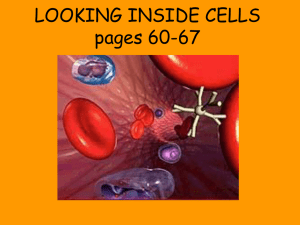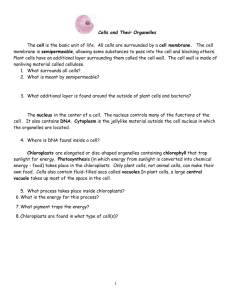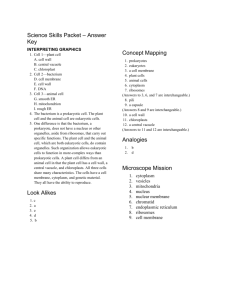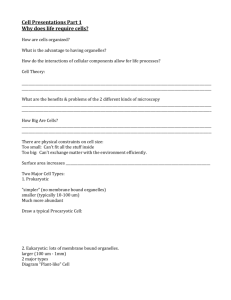The Molecules of Cells
advertisement
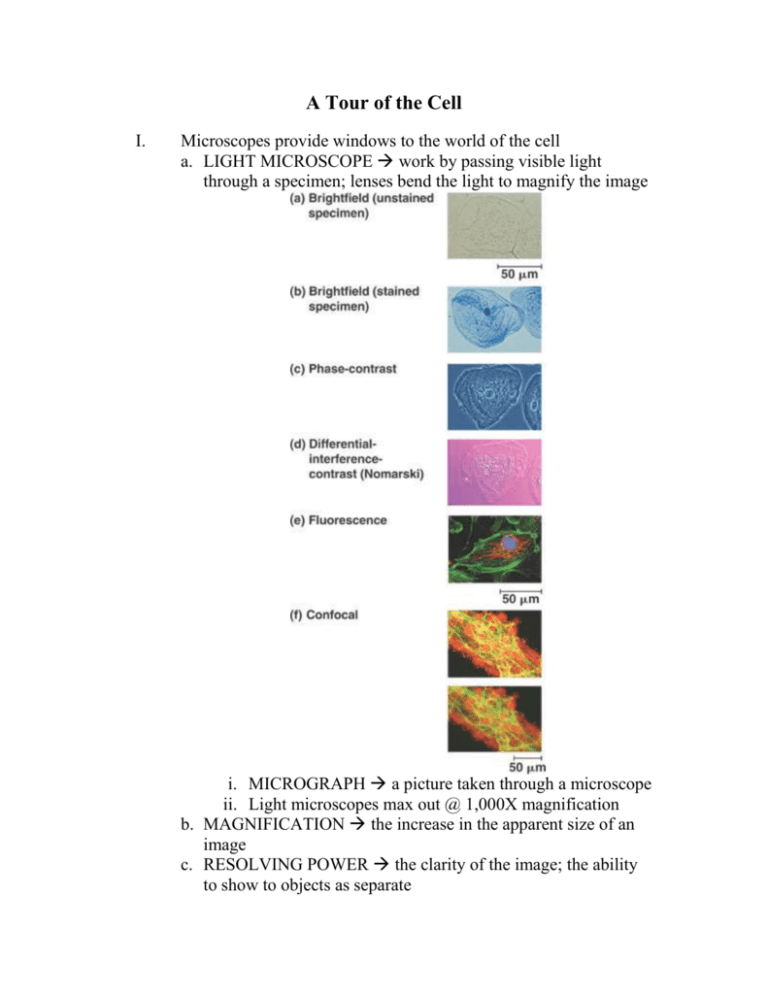
A Tour of the Cell I. Microscopes provide windows to the world of the cell a. LIGHT MICROSCOPE work by passing visible light through a specimen; lenses bend the light to magnify the image i. MICROGRAPH a picture taken through a microscope ii. Light microscopes max out @ 1,000X magnification b. MAGNIFICATION the increase in the apparent size of an image c. RESOLVING POWER the clarity of the image; the ability to show to objects as separate d. CELL THEORY all living things are composed of cells and all cells come from other cells e. ELECTRON MICROSCOPE uses a beam of electrons; 1,000X better than a Light Microscope i. Two types 1. SCANNING E.M. shows structural surface 2. TRANSMISSION E.M. shows internal structure II. Cell size vary with their function a. Bird eggs are big because they contain a large amount of nutrient for young b. Nerve cells are long to expedite signal transmission c. Blood cells are smaller to fit through vessels easily III. Natural laws limit cell size a. Minimum must be able to house DNA, proteins b. Maximum surface area to volume ratio IV. Prokaryotic cells are small and structurally simple a. PROKARYOTIC CELLS consist of bacteria and archaea i. NO MEMBRANE BOUND ORGANELLES ii. Usually smaller than eukaryotic cells (2–8 micrometers in length) iii. NUCLEOID (nucleus-like) region DNA coiled here iv. RIBOSOMES assemble amino acids into polypeptides v. PLASMA MEMBRANE surrounds the contents of the cell; separating it from its environment vi. PROKARYOTIC CELL WALL protects the cell and helps maintain shape vii. CAPSULE sticky out coat; protective viii. PILI short projections used to attach to surfaces ix. PROKARYOTIC FLAGELLA propel the cell through aquatic environment V. Eukaryotic cells are partitioned into functional compartments a. EUKARYOTIC CELLS animals, plants, protests, fungi i. MEMBRANE BOUND NUCLEUS ii. More complex than prokaryotes iii. CYTOPLASM fluid-filled region between the nucleus and plasma membrane iv. ORGANELLES the structures in the cytoplasm, help perform cell activities v. CELLULAR METABOLISM chemical activities of the cell vi. MEMBRANE BOUND ORGANELLES INCREASE VOLUME AND ALLOW MULTIPLE ACTIVITIES TO OCCUR SIMULTANEOUSLY vii. Animal cells and plant cells have overlapping organelles 1. LYSOSOMES, CENTRIOLES ONLY IN ANIMAL CELLS 2. CELL WALLS, CHLOROPLASTS ONLY IN PLANT CELLS VI. The nucleus is the cell’s genetic control center a. NUCLEUS genetic control center of the eukaryotic cell b. c. d. e. i. DNA is the hereditary blueprint CHROMATIN nuclear DNA attached to proteins forming long fibers CHROMOSOME fibers of chromatin NUCLEAR ENVELOPE double membrane with pore that control the flow of materials in and out NUCLEOLUS dense part inside nucleus; DNA + protein + RNA = ribosome production VII. Overview: Many cell organelles are related through the endomembrane system a. ENDOMEMBRANE SYSTEM network of organelles that work together in the synthesis, storage and export of important molecules VIII. Rough endoplasmic reticulum makes membrane and proteins a. ROUGH E.R. network of interconnected flattened sacs, covered with ribosomes, with two main functions i. Make more membrane ii. Make proteins secreted by the cell b. GLYCOPROTEIN protein with a sugar attached c. TRANSPORT VESSICLE tiny membranous sac to move secretory proteins IX. Smooth endoplasmic reticulum has a variety of functions a. SMOOTH E.R. continuous with rough E.R. but lacks ribosomes i. FUNCTIONS 1. Synthesis of lipids (fatty acids, phospholipids, steroids) 2. In liver the smooth ER a. Controls the amount of sugar b. Breakdown/detoxify drugs and other harmful substances i. Can lead to higher tolerance to drugs from increased smooth ER amounts 3. Storage of calcium ions a. Muscle tissue needs this for muscle contraction X. The Golgi apparatus finishes, sorts, and ships cell produces a. GOLGI APPARATUS series of flattened sacs; NOT INTERCONNCETED like the E.R. i. Function serves as a molecule warehouse and shipping factory ii. Receives transport vesicles from the E.R., chemically modifies the glycoproteins, then ships them to their respective destinations XI. Lysosomes digest the cell’s food and wastes a. LYSOSOMES “breakdown body”; contain hydrolytic enzymes i. Digest tiny food particles, bacteria, busted organelles ii. ENZYMES MUST BE KEPT WITHIN MEMBRANE TO PREVENT “SELF-DIGESTION” XII. Abnormal lysosomes can cause fatal diseases a. LYSOSOMAL STORAGE DISEASES hereditary disorder that impedes the enzyme function of lysosomes b. POMPE’S disease harmful amounts of glycogen build in the liver c. TAY-SACH’S lipids accumulate that damage the nerve cells XIII. Vacuoles function in the general maintenance of the cell a. VACUOLES membranous sacs that have various functions and comes in various shapes and sizes i. May store excess water, chemicals, wastes b. CONTRACTILE vacuole removes excess water i. Found in paramecium XIV. A review of the endomembrane system XV. Chloroplasts convert solar energy to chemical energy a. CHLOROPLASTS photosynthesizing organelles that convert light energy to chemical energy XVI. Mitochondria harvest chemical energy from food a. MITOCHONDRIA convert chemical energy (as in sugar) into a usable form (ATP) XVII. The cell’s internal skeleton helps organize its structure and activities a. CYTOSKELETON a supportive structure of fine fibers i. Fibers are also involved in cell movement b. 3 kinds of fibers i. MICROFILAMENTS thinnest fiber ii. MICROTUBULES thickest fiber iii. INTERMEDIATE FILAMENTS XVIII. Cilia and flagella move when microtubules bend a. CILIA short, numerous, hair-like projections that are involved in propulsion b. FLAGELLA longer, and fewer in number c. BASAL BODY anchoring structure; may act as foundation for growth d. DYNEIN ARMS protein knobs attached to each microtubule doublet i. Using ATP, exert a force which causes tubules to bend XIX. Cell surfaces protect, support, and join cells a. CELL JUNCTIONS structures that connect one cell to another i. 3 types of animal cell junctions 1. TIGHT JUNCTIONS 2. ANCHORING JUNCTIOINS 3. COMMUNICATING JUNCTIONS b. PLASMODESMATA channels between adjacent plant cells that form a circulatory and communication system c. EXTRACELLULAR MATRIX sticky layer of glycoproteins that cells are embedded XX. Eukaryotic organelles comprise four functional categories a. GENERAL FUNCTION : MANUFACTURE i. Nucleus ii. Ribosomes iii. Rough ER iv. Smooth ER v. Golgi Apparatus b. GENERAL FUNCTION : ENERGY PROCESSING i. Chloroplasts ii. Mitochondria c. GENERAL FUNCTION : BREAKDOWN i. Lysosomes ii. Peroxisomes iii. Vacuoles d. GENERAL FUNCTION: SUPPORT, MOVEMENT, AND COMMUNICATION BETWEEN CELLS i. Cytoskeleton ii. Cell Walls iii. Extracellular Matrix iv. Cell Junctions XXI. Extraterrestrial life forms may share features with life on Earth a. All life-forms on Earth share fundamental features i. Consist of cells, membrane bound and separate from environment ii. Have DNA as genetic material iii. Carry out metabolic processes *OTHER LIFE FORMS MAY NOT HAVE EXACT STRUCTURE OR MATERIAL, BUT FUNDAMENTAL CONCEPTS OVERLAP



